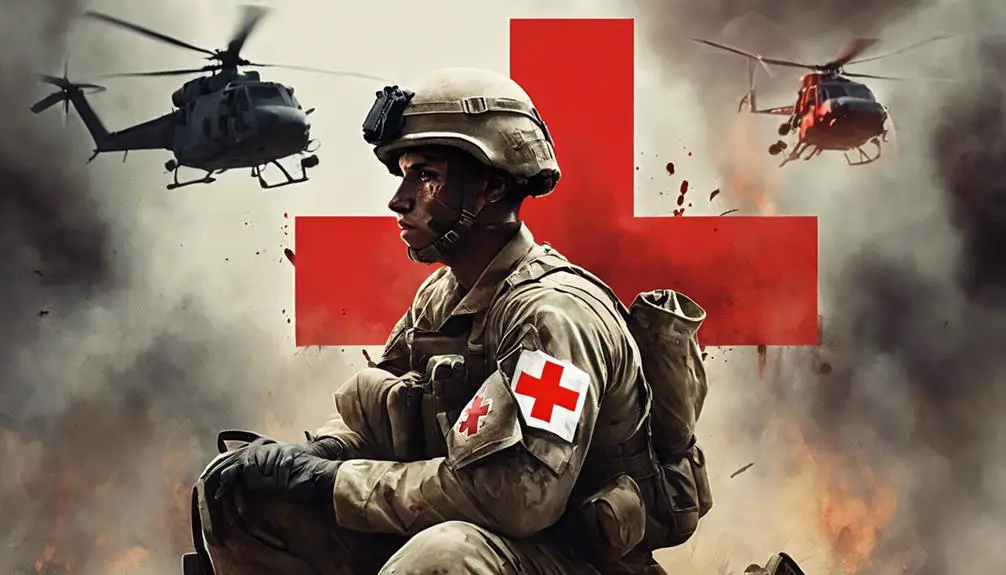You're about to enter the world of military medic lingo, where every second counts. Familiarize yourself with essential terms like MEDEVAC, TCCC, and trauma code to quickly communicate critical information. In the heat of battle, medics use slang terms like 'walking wounded' and 'mass cas' to prioritize patients. You'll learn to recognize key signs like pulse and breathing rate, and master radio protocols to convey crucial info. From prioritizing patients with colors to responding to chemical attacks, you'll discover the specialized language of military medics. As you proceed, you'll uncover more about the coded language that saves lives.
Battlefield Medical Lingo 101
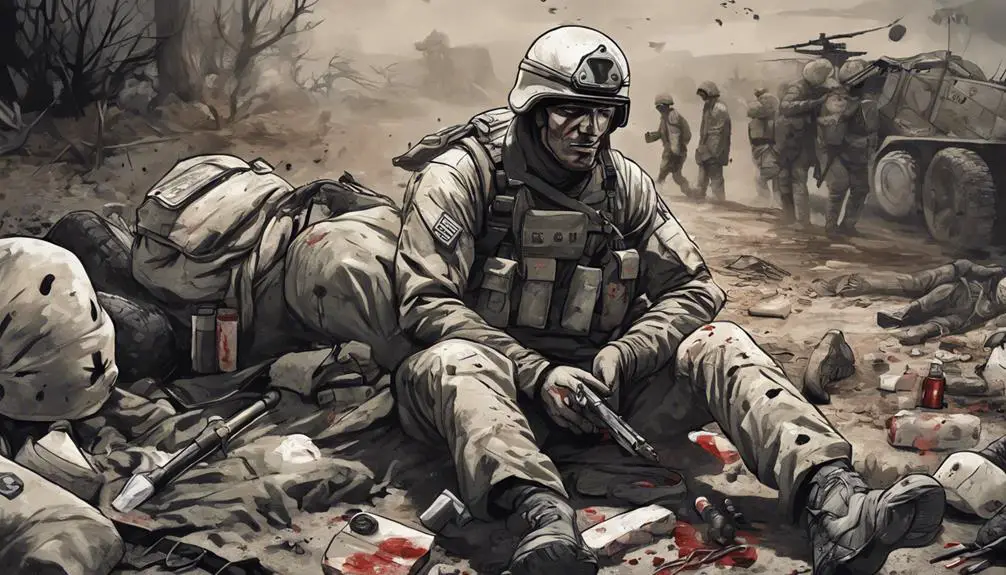
When you're in a combat zone, you'll quickly learn that medical personnel use a specific language to communicate efficiently and effectively, and grasping this lingo is essential to saving lives. Understanding medical histories is key, as it helps medics identify pre-existing conditions that may impact treatment. You'll need to know terms like 'MEDEVAC' (medical evacuation) and 'TCCC' (tactical combat casualty care).
In a high-stress environment, combat stress reactions are common. You'll hear terms like 'battle fatigue' or 'combat stress,' which describe the physical and emotional toll of combat. Recognizing these reactions is critical, as they can impair decision-making and put lives at risk. Medics will use phrases like 'psych eval' (psychological evaluation) to assess a soldier's mental state. Familiarize yourself with these terms, and you'll be better equipped to provide critical care in high-pressure situations. Remember, clear communication is key to saving lives on the battlefield.
Identifying Casualties on Scene
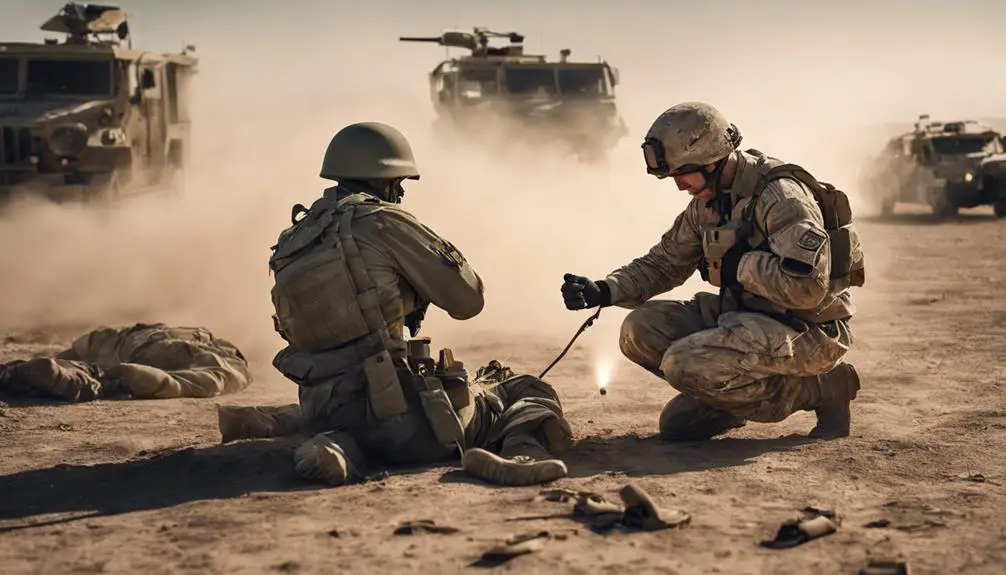
On the battlefield, you'll need to quickly identify casualties and evaluate their conditions to provide effective care, and an essential step in this process is recognizing the different types of casualties. You must be able to identify and categorize casualties based on their injuries, which will guide your treatment decisions. Recognizing key signs, such as pulse, breathing rate, and blood pressure, is critical in determining the severity of the casualty's condition.
You'll also need to follow established triage protocols to prioritize care and allocate resources effectively. This involves rapidly evaluating the casualty's condition and assigning a triage category based on the severity of their injuries. By quickly identifying the type and severity of the casualty's injuries, you'll be able to provide targeted care and maximize the chances of survival. Remember, every second counts on the battlefield, and accurate identification of casualties is essential in saving lives.
Prioritizing Patients With Colors
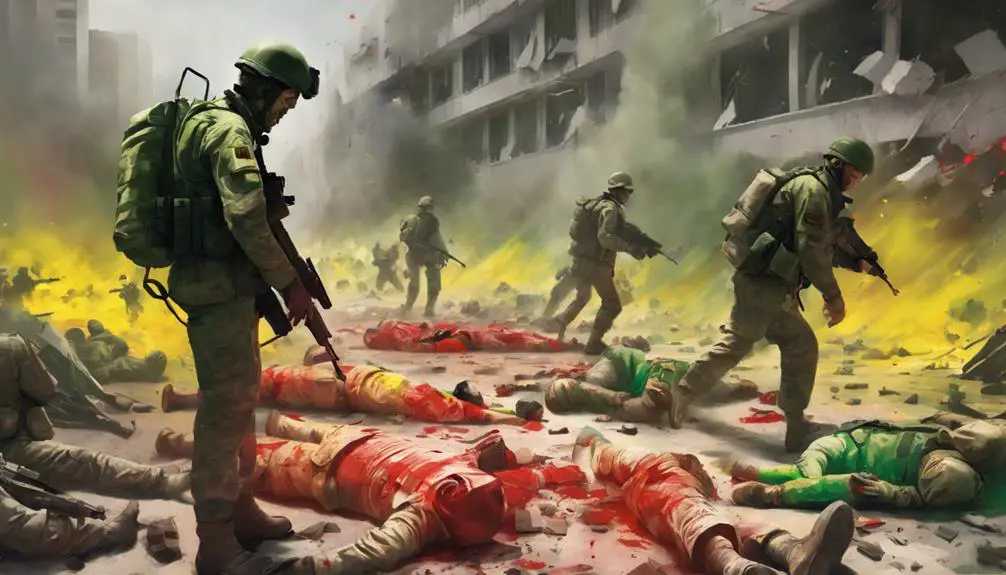
As you rapidly assess the casualties, you'll categorize them using a color-coded system to prioritize care, with red indicating immediate attention, yellow signifying delayed care, green indicating ambulatory patients, black indicating expectant or deceased, and gray indicating unknown or uncertain status. This color-coded system helps you navigate the chaos of a mass casualty incident, making sure you provide care to those who need it most urgently.
In the midst of color-coded chaos, patient prioritization protocols guide your decision-making. Red patients require immediate attention, as their injuries are life-threatening. Yellow patients, while stable, still require care, but can wait. Green patients are ambulatory and can assist with their own care. Black patients are either deceased or expectant, and gray patients' status is unknown or uncertain. By categorizing patients using this system, you'll guarantee that those who need immediate care receive it, and resources are allocated efficiently. This system is vital in high-pressure situations, allowing you to prioritize patients effectively and provide the best possible care.
Common Medic Slang Terms
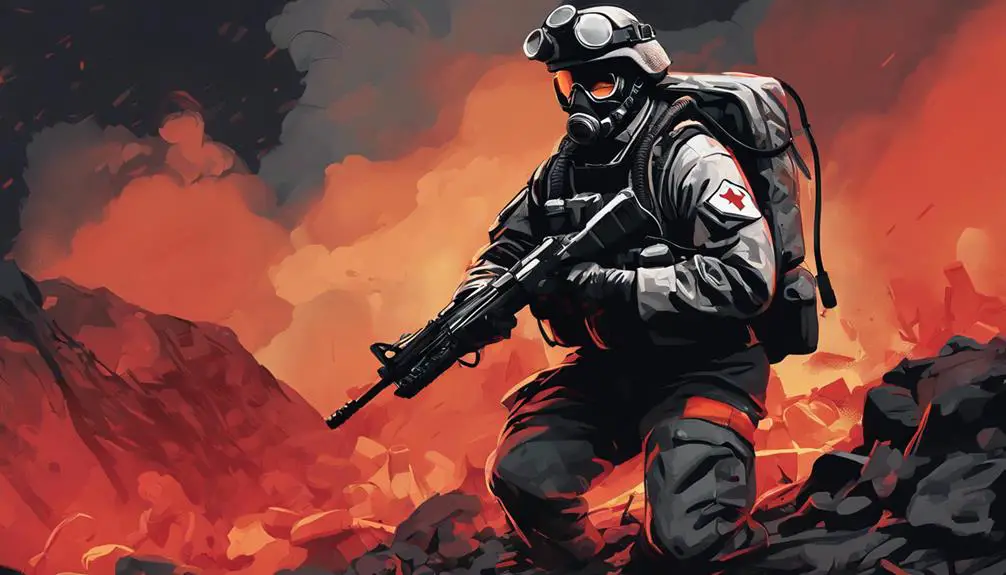
In the heat of a mass casualty incident, you'll often rely on medic slang to quickly communicate with your team and prioritize patient care. In combat zones, every second counts, and using medical jargon can save lives. Familiarizing yourself with common medic slang terms is vital to effective communication.
You'll frequently hear terms like 'trauma code' to indicate a critical patient, 'walking wounded' to describe patients with minor injuries, and 'expectant' to identify those with fatal injuries. 'Mass cas' or 'MCI' denotes a mass casualty incident, while 'MEDEVAC' refers to medical evacuation. 'RTD' means return to duty, signifying a patient is fit to resume their role. 'TCCC' stands for Tactical Combat Casualty Care, the standard for medical care in combat zones.
Understanding these terms enables you to quickly convey patient information, prioritize care, and make swift decisions in high-pressure situations. By adopting medic slang into your vocabulary, you'll enhance your communication and response times, ultimately saving lives in the process.
Radio Communication Codes
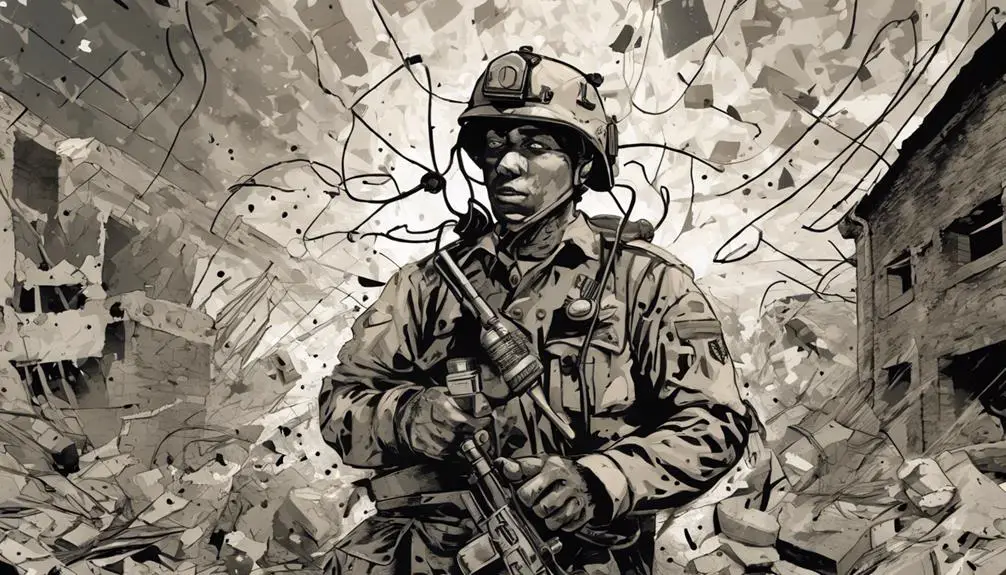
During high-stress combat situations, you'll rely on radio communication codes to swiftly convey critical information to your team, guaranteeing seamless coordination and rapid response. Effective radio communication is vital in medical emergency situations, where every second counts. To achieve this, you'll need to master radio protocol brevity, conveying complex information in a concise and clear manner. This includes using standardized codes and abbreviations to minimize transmission time and reduce the risk of miscommunication.
Tactical frequency management is also essential, as it enables you to quickly switch between different communication channels to adapt to changing situations. This might involve switching to a secure frequency to discuss sensitive information or switching to a backup channel in case of radio interference. By following established radio protocols and maintaining discipline on the radio, you'll ensure that critical information is conveyed efficiently, allowing your team to respond swiftly and effectively in high-pressure situations.
Evacuation and Transport Terms
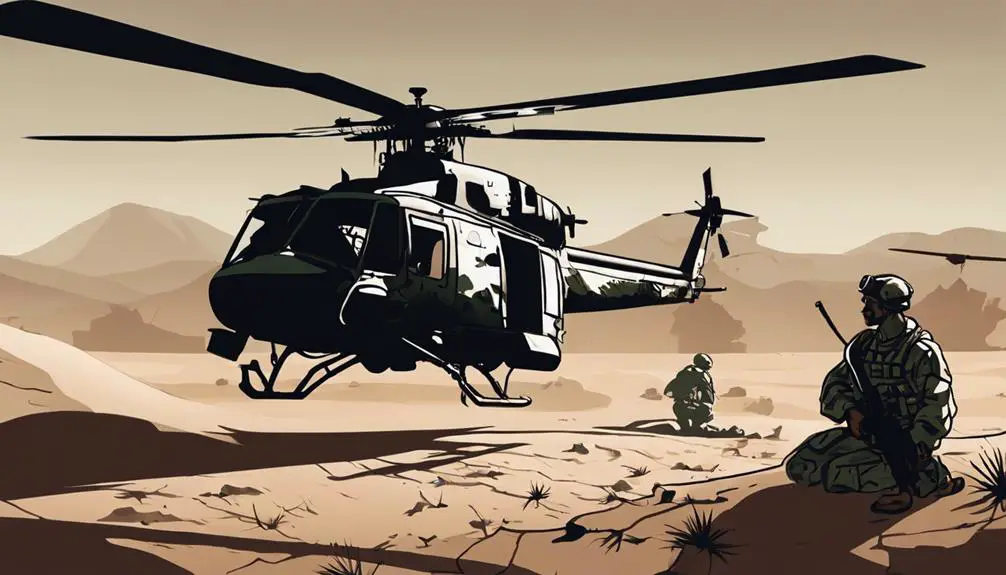
You'll need to familiarize yourself with evacuation and transport terms to efficiently coordinate medical evacuations, ensuring timely and effective transportation of casualties to medical facilities. Understanding these terms is vital in emergency situations where every minute counts. Aerial evacuation, for instance, refers to the transportation of casualties by air, which is often the fastest way to reach medical facilities. Medical regrouping, on the other hand, involves the reorganization of medical resources and personnel to enhance efficiency and response times.
Familiarity with these terms enables you to effectively communicate with other medical personnel and coordinate evacuation efforts seamlessly. You'll be able to quickly identify the type of evacuation required, whether it's an urgent or routine transport, and allocate resources accordingly. This knowledge will also help you to prioritize casualties, allocate medical resources, and ensure that patients receive the necessary care in a timely manner. By mastering evacuation and transport terms, you'll be better equipped to save lives and improve patient outcomes.
Medevac Vs CASEVAC
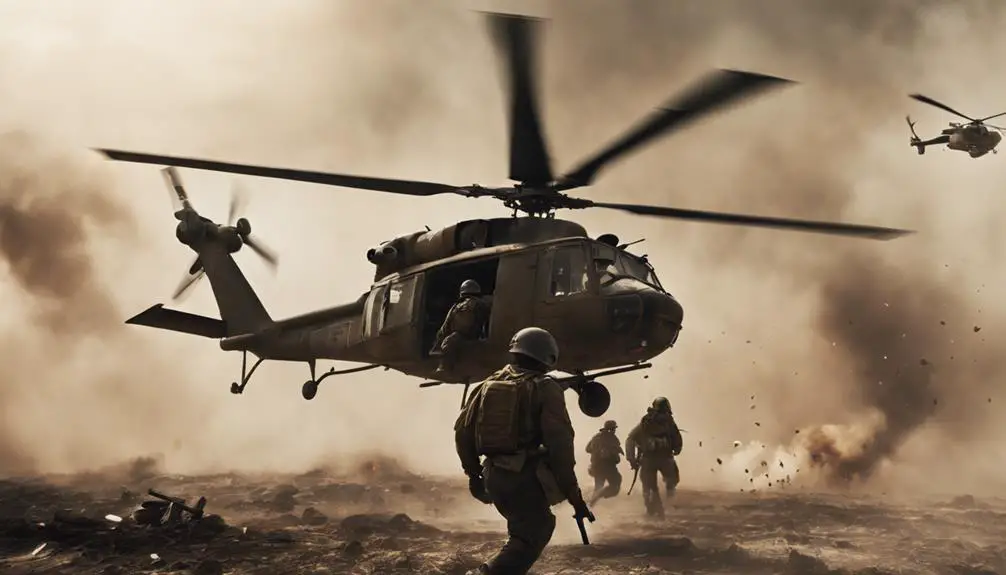
Every military medic should understand the distinction between Medevac and CASEVAC, two critical concepts that can greatly impact the success of medical evacuation operations. As a medic, you'll encounter situations where timely and effective medical evacuation is important. Medevac, short for medical evacuation, refers to the transport of patients from a medical treatment facility to a higher level of care. This can include aeromedical prep, where patients are prepared for air transport to a more advanced medical facility. On the other hand, CASEVAC, or casualty evacuation, involves the rapid transport of wounded personnel from the battlefield to a medical treatment facility. This often requires tactical deployment of medical personnel and equipment to reach the casualty. Understanding the difference between Medevac and CASEVAC is essential, as it enables you to prioritize and allocate resources effectively, ensuring the best possible care for wounded personnel. By recognizing the distinct roles of Medevac and CASEVAC, you can optimize your response and improve patient outcomes.
Wounded Soldier Slang Expressions

In the chaos of combat, medics often rely on shorthand phrases and slang expressions to quickly communicate the status of wounded soldiers. You'll hear phrases like 'urgent surgical' to indicate a critical injury requiring immediate attention. A 'trauma alpha' signals a severe injury with multiple wounds. When a soldier is badly hurt, you might hear a 'warrior's cry,' a loud, urgent call for help.
You'll also hear medics referring to a wounded soldier's 'combat buddy,' the fellow soldier who stays with them until medical help arrives. This buddy provides vital information about the soldier's injuries and helps keep them calm until medical attention is received.
In the heat of battle, every second counts. Using slang expressions and shorthand phrases enables medics to quickly assess and treat wounded soldiers. It's a language that's direct, concise, and life-saving. As a medic, you'll need to be familiar with these expressions to provide the best possible care in high-pressure situations.
Medic Response to Chemical Attacks
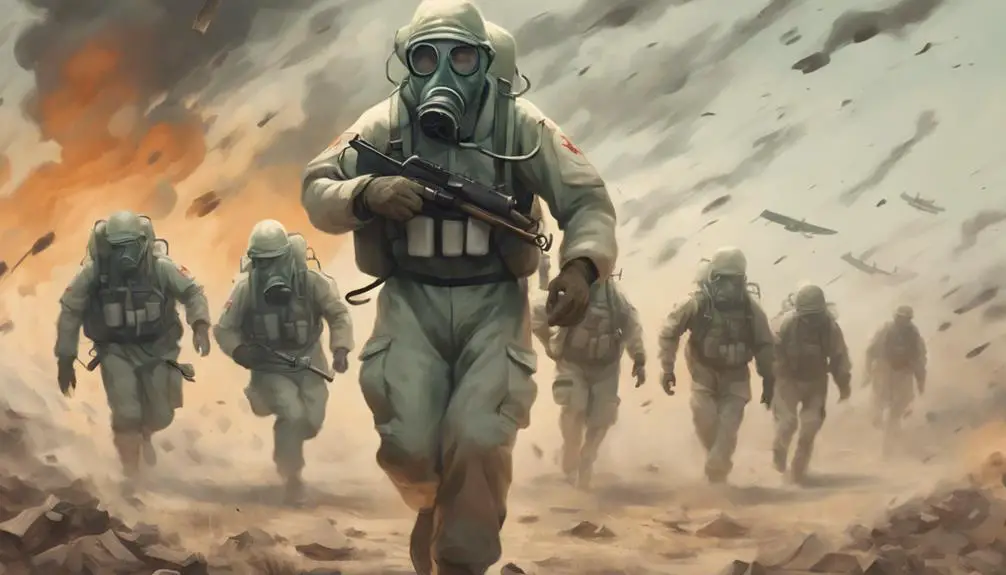
When responding to a chemical attack, your top priority as a medic is to guarantee your own protection before treating casualties, since even low-level exposure can be debilitating. Don't compromise your own safety, as it's essential to make sure you can provide effective care to those in need.
First, don your personal protective equipment (PPE), including a gas mask, gloves, and suits. This will prevent skin contact and inhalation of toxic substances. Next, establish a decontamination zone, where casualties can be safely cleaned and treated. Implement decontamination protocols, such as removing contaminated clothing and washing affected areas. Be prepared to administer antidotes or other medical countermeasures as needed. Remember to monitor your surroundings and watch for signs of exposure in yourself and others. Stay alert and focused to provide the best possible care in this high-stress situation.
De-escalation and Triage Phrases
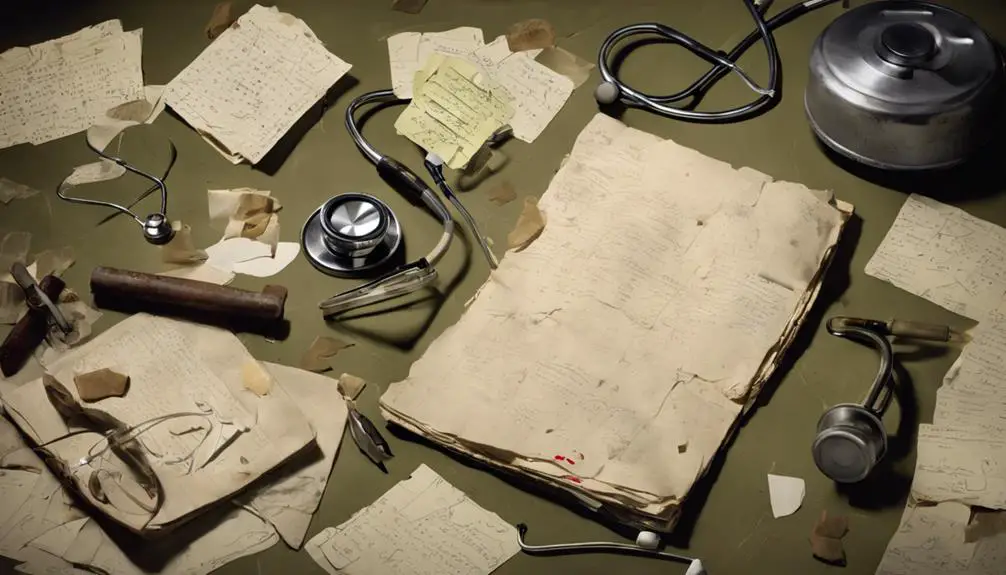
You'll need to employ effective communication skills to de-escalate situations and prioritize casualties, using specific phrases to convey urgency and promote a sense of calm. In high-stress environments, it's essential to remain composed and use stress management techniques to maintain focus. When communicating with casualties, use patient reassurance methods to alleviate anxiety and promote cooperation.
To de-escalate, use phrases like 'I'm here to help' or 'We're doing everything we can.' When triaging, prioritize patients using the 'MEDEVAC' criteria: Massive bleeding, Eyes/throat/chest injuries, Difficulty breathing, Entrapment, and Vital signs. Use clear, concise language to convey treatment plans and provide reassurance. For example, 'We're going to get you out of here safely' or 'You're going to be okay, we've got you.' Remember to maintain a calm tone and avoid using jargon or technical terms that may confuse patients. By employing these de-escalation and triage phrases, you'll effectively manage chaotic situations and provide quality care under pressure.
Frequently Asked Questions
What Is the Protocol for Treating a Medic Injured in Combat?
When you're treating a medic injured in combat, your priority is stabilizing their condition. Begin with Trauma Triage, quickly evaluating their injuries to identify life-threatening wounds. Adopt a Medic Mindset, staying focused and calm under pressure. Next, provide basic life support, controlling bleeding and maintaining airways. If possible, evacuate the medic to a higher level of care, but only when the situation allows. Your goal is to stabilize and transport, not to treat extensively in the combat zone.
Can Non-Medical Personnel Assist in Emergency Situations?
You're on the battlefield, chaos erupts, and a fellow soldier goes down. In this emergency, every second counts. You, as non-medical personnel, can assist in the response. Don't hesitate to provide bystander assistance, following basic life-saving protocols. Your prompt action can mean the difference between life and death. Remember, emergency response is a collective effort; your role is vital in stabilizing the situation until medical professionals arrive.
How Do Medics Handle Confidential Patient Information?
When handling confidential patient information, you must follow strict guidelines. Patient confidentiality is paramount, and breaching doctor-patient privilege can have severe consequences. You're required to maintain confidentiality, only sharing information on a need-to-know basis. Guarantee all records and documents are secure, and access is restricted to authorized personnel. Remember, confidentiality is a patient's right, and it's your duty to protect it.
What Is the Process for Reporting Medical Errors or Near-Misses?
When reporting medical errors or near-misses, you'll follow established error reporting protocols. This involves documenting the incident, including details of what happened, when, and who was involved. A root cause analysis will then be conducted to identify the underlying causes of the error. This helps you understand what went wrong and how to prevent similar incidents in the future. You'll also be required to notify the relevant authorities and take corrective actions to improve patient safety.
Can Medics Refuse Treatment to Hostile or Enemy Forces?
As you storm the battlefield, the sounds of clashing steel and cannons firing echo through the air, transporting you back to the medieval era. But amidst the chaos, you're faced with an important decision: can you refuse treatment to an enemy combatant? The answer is no. As a medic, your duty is to provide medical care regardless of allegiance. You must prioritize patients based on triage protocol, not allegiance. Your oath is to heal, not to discriminate.

